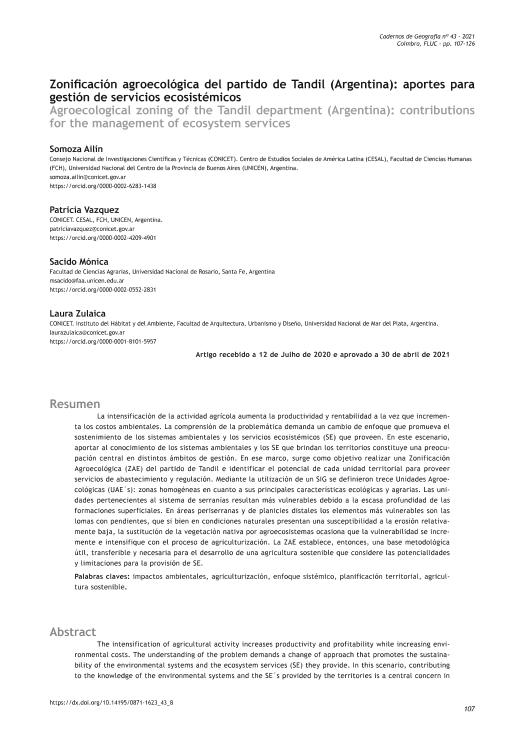Artículo
La intensificación de la actividad agrícola aumenta la productividad y rentabilidad a la vez que incrementa los costos ambientales. La comprensión de la problemática demanda un cambio de enfoque que promueva el sostenimiento de los sistemas ambientales y los servicios ecosistémicos (SE) que proveen. En este escenario, aportar al conocimiento de los sistemas ambientales y los SE que brindan los territorios constituye una preocupación central en distintos ámbitos de gestión. En ese marco, surge como objetivo realizar una Zonificación Agroecológica (ZAE) del partido de Tandil e identificar el potencial de cada unidad territorial para proveer servicios de abastecimiento y regulación. Mediante la utilización de un SIG se definieron trece Unidades Agroecológicas (UAE´s): zonas homogéneas en cuanto a sus principales características ecológicas y agrarias. La ZAE introduce una base metodológica útil, transferible y necesaria para el desarrollo de una agricultura sostenible que considere las potencialidades y limitaciones para la provisión de SE. The intensification of agricultural activity increases productivity and profitability while increasing environmental costs. The understanding of the problem demands a change of approach that promotes the sustainability of the environmental systems and the ecosystem services (SE) they provide. In this scenario, contributing to the knowledge of the environmental systems and the SE´s provided by the territories is a central concern in different areas of management. The aim of this study is to carry out an Agroecological Zoning (ZAE) of the Tandil department and identify the potential of each territorial unit to provide supply and regulation services. Through the use of a GIS, Agroecological Units (UAE’s) were defined: homogeneous zones in terms of their main ecological and agricultural characteristics. Units belonging to the mountainous system are more vulnerable due to the shallow depth of the surface formations. In periserran areas and distal plains, the most vulnerable elements are the sloping hills, which, although in natural conditions have a relatively low susceptibility to erosion, the substitution of native vegetation for agroecosystems causes vulnerability to increase and intensify over time. agriculturalization process. The ZAE introduces a useful, transferable and necessary methodological basis for the development of sustainable agriculture that considers the potential and limitations for the provision of SE.
Zonificación agroecológica del partido de Tandil (Argentina): aportes para gestión de servicios ecosistémicos
Título:
Agroecological zoning of the Tandil department (Argentina): contributions for the management of ecosystem services
Fecha de publicación:
06/2021
Editorial:
Universidade de Coimbra
Revista:
Cadernos de Geografia
ISSN:
0871-1623
e-ISSN:
2183-4016
Idioma:
Español
Tipo de recurso:
Artículo publicado
Clasificación temática:
Resumen
Archivos asociados
Licencia
Identificadores
Colecciones
Articulos(CCT - TANDIL)
Articulos de CTRO CIENTIFICO TECNOLOGICO CONICET - TANDIL
Articulos de CTRO CIENTIFICO TECNOLOGICO CONICET - TANDIL
Citación
Somoza, Ailin; Vazquez, Patricia Susana; Sacido, Monica Benita; Zulaica, Maria Laura; Zonificación agroecológica del partido de Tandil (Argentina): aportes para gestión de servicios ecosistémicos; Universidade de Coimbra; Cadernos de Geografia; 43; 6-2021; 107-126
Compartir
Altmétricas




